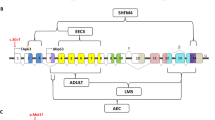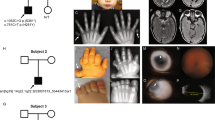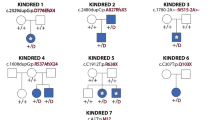Abstract
Formation of the secondary palate is a complex step during craniofacial development. Disturbance of the events affecting palatogenesis results in a failure of the palate to close. As a consequence of deformity, an affected child will have problems with feeding, speech, hearing, dentition and psychological development. Cleft palate occurs frequently, affecting approximately 1 in 1,500 births; it is usually considered a sporadic occurrence1 resulting from an interaction between genetic and environmental factors2. Although several susceptibility loci have been implicated, attempts to link genetic variation to functional effects have met with little success3. Cleft palate with ankyloglossia (CPX; MIM 303400) is inherited as a semidominant X-linked disorder previously described in several large families of different ethnic origins4,5,6,7,8,9,10,11 and has been the subject of several studies that localized the causative gene to Xq21 (refs. 10–13). Here we show that CPX is caused by mutations in the gene encoding the recently described T-box transcription factor TBX22 (ref. 14). Members of the T-box gene family are known to play essential roles in early vertebrate development, especially in mesoderm specification15. We demonstrate that TBX22 is a major gene determinant crucial to human palatogenesis. The spectrum of nonsense, splice-site, frameshift and missense mutations we have identified in this study indicates that the cleft phenotype results from a complete loss of TBX22 function.
This is a preview of subscription content, access via your institution
Access options
Subscribe to this journal
Receive 12 print issues and online access
$209.00 per year
only $17.42 per issue
Buy this article
- Purchase on Springer Link
- Instant access to full article PDF
Prices may be subject to local taxes which are calculated during checkout




Similar content being viewed by others
References
Leck, I. The geographical distribution of neural tube defects and oral clefts. Br. Med. Bull. 40, 390–395 (1984).
Fraser, F.C. The genetics of cleft lip and palate: yet another look. in Current Research Trends in Prenatal Craniofacial Development (eds R.M. Pratt and K.L. Christiansen) 357–366 (National Institutes of Health, 1980).
Wilkie, A.O. & Morriss-Kay, G.M. Genetics of craniofacial development and malformation. Nature Rev. Genet. 2, 458–468 (2001).
Bjornsson, A., Arnason, A. & Tippet, P. X-linked cleft palate and ankyloglossia in an Icelandic family. Cleft Palate J. 26, 3–8 (1989).
Lowry, R.B. Sex linked cleft palate in a British Columbia Indian family. Pediatrics 46, 123–128 (1970).
Rushton, A.R. Sex linked inheritance of cleft palate. Hum. Genet. 48, 179–181 (1979).
Rollnick, B.R. & Kaye, C.I. Mendelian inheritance of isolated nonsyndromic cleft palate. Am. J. Med. Genet. 24, 465–473 (1986).
Bixler, D. Letter to the editor: X-linked cleft palate. Am. J. Med. Genet. 28, 503–505 (1987).
Hall, B.D. Letter to the editor: a further X-linked isolated nonsyndromic cleft palate family with a nonexpressing obligate affected male. Am. J. Med. Genet. 26, 239–240 (1987).
Gorski, S.M., Adams, K.J., Birch, P.H., Friedman, J.M. & Goodfellow, P.J. The gene responsible for X-linked cleft palate (CPX) in a British Columbia native kindred is localized between PGK1 and DXYS1. Am. J. Hum. Genet. 50, 1129–1136 (1992).
Gorski, S.M. et al. Linkage analysis of X-linked cleft palate and ankyloglossia in Manitoba Mennonite and British Columbia Native kindreds. Hum. Genet. 94, 141–148 (1994).
Moore, G.E. et al. Linkage of an X-chromosome cleft palate gene. Nature 326, 91–92 (1987).
Stanier, P. et al. The localization of a gene causing X-linked cleft palate and ankyloglossia (CPX) in an Icelandic kindred is between DXS326 and DXYS1X. Genomics 17, 549–555 (1993).
Laugier-Anfossi, F. & Villard, L. Molecular characterization of a new human T-box gene (TBX22) located in xq21.1 encoding a protein containing a truncated T-domain. Gene 255, 289–296 (2000).
Papaioannou, V.E. & Silver, L.M. The T-box gene family. BioEssays 20, 9–19 (1998).
Forbes, S.A. et al. Refined mapping and YAC contig construction of the X-linked cleft palate and ankyloglossia locus (CPX) including the proximal X-Y homology breakpoint within Xq21.3. Genomics 31, 36–43 (1996).
Braybrook, C. et al. Physical and transcriptional mapping of the X-linked cleft palate and ankyloglossia (CPX) critical region. Hum. Genet. 108, 537–545 (2001).
Richardson, M.P., Braybrook, C., Tham, M., Moore, G.E. & Stanier, P. Molecular cloning and characterization of a highly conserved human 67k-Da laminin receptor pseudogene mapping to Xq21.3. Gene 206, 145–150 (1998).
Braybrook, C. et al. Identification and characterization of KLHL4, a novel human homologue of the Drosophila kelch gene that maps within the X-linked cleft palate and ankyloglossia (CPX) critical region. Genomics 72, 128–136 (2001).
Wiktop, C.J., MacCollum, D.W. & Rubin, A. Handbook of Congenital Malformations (Saunders, Philadelphia, 1967).
Prescott, N.J., Lees, M.M, Winter, R.M. & Malcolm, S. Identification of susceptibility loci for nonsyndromic cleft lip with or without cleft palate in a two stage genome scan of affected sib-pairs. Hum. Genet. 106, 345–350 (2000).
Culbertson, M.R. RNA surveillance. Unforeseen consequences for gene expression, inherited genetic disorders and cancer. Trends Genet. 15, 74–80 (1999).
Sözen, M.A. et al. Mutation of PVRL1 is associated with sporadic, non-syndromic cleft lip/palate in northern Venezuela. Nature Genet. 29, 141–142 (2001).
Dobrovolskaia-Zavadskaia, N. Sur la mortification spontanée de la queue chez la souris nouveau-née et sur l'existence d'un caractère (facteur) héréditaire 'non-viable'. C. R. Seanc. Soc. Biol. 97, 114–116 (1927).
Wilkinson, D.G., Bhatt, S. & Herrmann, B.G. Expression pattern of the mouse T gene and its role in mesoderm formation. Nature 343, 657–659 (1990).
Bamshad, M. et al. Mutations in human TBX3 alter limb, apocrine and genital development in ulnar-mammary syndrome. Nature Genet. 16, 311–315 (1997).
Basson, C.T. et al. Mutations in human TBX5 cause limb and cardiac malformation in Holt-Oram syndrome. Nature Genet. 15, 30–35 (1997).
Jerome, L.A. & Papaioannou, V.E. DiGeorge syndrome phenotype in mice mutant for the T-box gene, Tbx1. Nature Genet. 27, 286–291 (2001).
Lindsay, E.A. et al. Tbx1 haploinsufficiency in the DiGeorge syndrome region causes aortic arch defects in mice. Nature 410, 97–101 (2001).
Tada, M. & Smith, J.C. T-targets: clues to understanding the functions of T-box proteins. Dev. Growth Differ. 43, 1–11 (2001).
Proetzel, G. et al. Transforming growth factor–β 3 is required for secondary palate fusion. Nature Genet. 11, 409–414 (1995).
Wakeling, E.L., Abu-Amero, S.N., Stanier, P., Preece, M.A. & Moore, G.E. Human EGFR, a candidate for the Silver-Russell syndrome, is biallelically expressed in a wide range of fetal tissues. Eur. J. Hum. Genet. 6, 158–164 (1998).
Acknowledgements
We wish to thank R. Williamson, O. Jensson, C. Greenberg, J. Freidman, A. Ivens, S. Forbes, M. Richardson, M. Tham, V. Mandryko, L. Bentley, M.T. Ross and members of the Sanger Centre Human X Chromosome Project Team for their invaluable contributions to this study; A. Davies and S. Bayliss for DNA sequencing; the families and patients studied for their participation; and M. Parker and A.J. Copp for critical reading of the manuscript. This work was supported by the Birth Defects Foundation United Kingdom, the Dunhill Medical Trust, the Medical Research Council, the Icelandic Research Council and the Hayward Foundation.
Author information
Authors and Affiliations
Corresponding author
Supplementary information
Rights and permissions
About this article
Cite this article
Braybrook, C., Doudney, K., Marçano, A. et al. The T-box transcription factor gene TBX22 is mutated in X-linked cleft palate and ankyloglossia. Nat Genet 29, 179–183 (2001). https://doi.org/10.1038/ng730
Received:
Accepted:
Published:
Issue Date:
DOI: https://doi.org/10.1038/ng730
This article is cited by
-
Novel TBX22 mutations in Chinese nonsyndromic cleft lip/palate families
Journal of Genetics (2018)
-
Chromosome 22q12.1 microdeletions: confirmation of the MN1 gene as a candidate gene for cleft palate
European Journal of Human Genetics (2016)
-
Tongue Tie in Infancy
Current Treatment Options in Pediatrics (2016)
-
Tooth agenesis and orofacial clefting: genetic brothers in arms?
Human Genetics (2016)
-
Loss-of-function mutation in the X-linked TBX22 promoter disrupts an ETS-1 binding site and leads to cleft palate
Human Genetics (2015)



